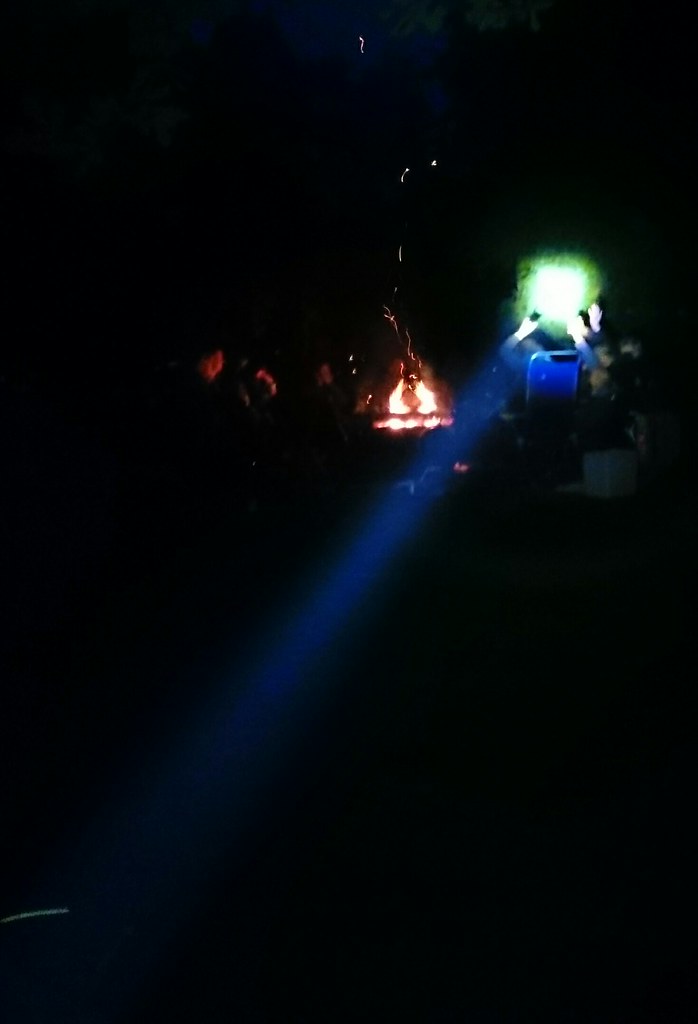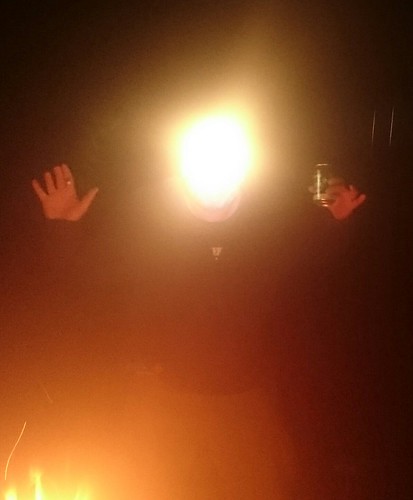Do you have any idea if calibrating with a lower output light like that would be better, worse, or no different than calibrating with a higher output light? I’m not familiar enough with the specifics of how they measure to know if they’re going to be the same percentage off through their whole measurement range. I don’t measure many 25kcd lights, but I measure a lot at 100-500kcd.
Sure it is not ideal, but in my limited experience with the luxmeters I own, lineairity was very good, also with cheap chinese ones, so I think that you get away fine with calibrating with a lower output light
I make lower output reference lights because it is much easier to get the output very constant (less problems with heat sag and varying battery sag). It is way cheaper too, the host is cheaper and because of the small size I can send it as a 'letter box' package, which is 3 dollar worldwide instead of 12+.
Here’s a poor picture of the above mentioned 1405 hitting some low cloud cover. This thing is awesome. I’m going to try the lens I have with a shorter focal length and see if the throw changes at all, I’m hoping it doesn’t go down, I can’t remember what effect it had on the one it’s on now.

Nice work. There shouldn't be a significant vF difference between different XP-L bins, but there is a difference between production batches, and I wouldn't be surprised to see the vF go up and them become more fragile like the XM-L2s have.
I always struggle with requests to publish throw and lumen numbers, because I know that my meters are not accurate. They are a good comparison tool, but if someone "took me to court" to verify the accuracy of the numbers, there is no way they would hold up. I use them far more to compare with my own stuff (e.g. before and after mod. measurements), but I don't trust them at all to compare against others results. I know some guys who have the same or similar built lights who measure significantly higher than I do and others that measure significantly lower.
Just my 2c, but I don't get too caught up in comparing with others because must of us have level measuring equipment and use inconsistent measuring methodologies. It's fun to compare, but I don't get too wound up with the inconsistencies. The only way to get comparable numbers would be to measure the lights back-to-back, same day, same place, same meter. I'm not saying that the different data points from everyone aren't valuable--because they are, but don't get too hung up on expecting your measurements to be identical to others' measurements.
Nice beamshot KKW ![]()
I am surprised we haven’t seen more hotrodded 1405/1504 beamshots, they look great when maxed out, especially when there is lots of moisture in the air like all throwers ![]()
I'm out camping right now, but did not bring the 1405. I did bring the shortened 1406 and will do a beamshot tonight :-)
How nice to be out camping ![]() and i see you guys in Holland have gotten summer already, here in Sweden it is still ways off and it is almost June
and i see you guys in Holland have gotten summer already, here in Sweden it is still ways off and it is almost June ![]()
19degC and sunny all day, group camping with a couple of families, drinking coffe and beer and bbq+camp fire at night :bigsmile:
A bit blurry but here's a bbq-beamshot with the 1406-shorty :-) :
https://farm6.staticflickr.com/5344/17866863200_55e2ba4015_b.jpg
(sorry, can't get the photo into the editor on my phone)
A bit blurry but here’s a bbq-beamshot with the 1406-shorty
:
https://farm6.staticflickr.com/5344/17866863200_55e2ba4015_b.jpg
(sorry, can’t get the photo into the editor on my phone)
Thanks pd68, one more then, 230kcd in J.'s face (eyes closed btw ;-) ) :
I will fix the image tomorrow.
Again remember that although you can calibrate different meters from the same LEDs placed in a host, the argument against many meters is that they are highly spectral dependent. The moment that one new tint (basically any different LED) enters the group, the calibration is once again reset to being in an unknown relation to it. An LED’s true lumen rating is going to be based on an average curve of light energy that is a result of a combination of colors, but like a CFL bulb, they have spectra falling “all over the place” you might say. The optimum way to do it, would be to purchase 1 single JETI Specbos 1211 reference spectroradiometer, and then the lights are sent to the holder of that unit for testing. In other words, your throne seat here costs about $8500.
I would like to have this one tested:


As much as we may wish to measure our lights perfectly, it is not going to happen, the variation between lights and between people will not get closer than a few percent, perhaps even 10. The attempt here is to get the measurements a bit less all over the place, and that is feasable.
I think MEM is cooking something good :)
This is around 2MCD?
We need the man who can brake all records...
Holy crap MEM. That’s a fire setting laser!!!
As much as we may wish to measure our lights perfectly, it is not going to happen, the variation between lights and between people will not get closer than a few percent, perhaps even 10. The attempt here is to get the measurements a bit less all over the place, and that is feasable.
That’s exactly right, everyone wants to get all perfect and other nonsense, not possible with the quality of meters, and time most of us have. I’ll be happy to get everyone corrected to within 5% of each other for the people who have consistent, but inaccurate meters. Doing a CW, NW, and WW version and having them measured and passed around eliminates the error causes by variations in lenses, and LED’s, and should bring us closer to the 5% mark than 10% I would hope.
Perfect is for theory, we work in reality.
I like to believe I work in reality. If I could be paid for working in dreams, I would have been a made-man long ago. ![]()
Not trying to batter your idea(s) down. I was merely expressing the idea that maybe the planning/structure of this method could possibly be improved, such as using those with the same meter types first, etc. Or at least make requirements: measure at a specific distance of 10 meters, and post some certain data from those calibrating (before/after calibration measurement-ranges and differences with tints that are well under or over the expected ranges I.E. Hi-CRI 3000K & a lower CRI ~7000K or even one or two different tint CFL bulbs passed around as a secondary way to compare variance). Yes it would be a good idea if a meter type was made a standard, at least for a group of testers. That way if you owned meter type “X”, those meters are part of the group once calibrated. I would purchase whatever meter you guys choose to calibrate on just to be a part of a testing standard that is BLF-native. ![]()
I guess what I’m hearing that sounds slightly off, is that you are saying to pass around these different tints, with the new calibration occurring on different meters, with other data showing how a “good calibrated meter” is varying vast percentages higher than 10% from a reference meter between light sources. Then, finally saying that people will be calibrated to within hopefully 5-10% of one another.
The 5-10% expectation would have to come from somewhere. See what I mean? There would need to be calibration sources that first document TINT effects on the primary meter type vs its lux output readings. To create calibration sources that are known in their differences when tested on meter “X”, you must first start with known calibration sources. That points right back to a professional spectroradiometer to document the calibrating sources to take back to your meters and pass around.
What may be unrealistic to some is the notion any will pay $8500 for a spectroradiometer to test budget lights. I understand that. What might be a little more realistic, would be finding a source to one of these meters, and then simply paying that owner to document the calibration sources. This should be quite feasible and easy to do. There are most likely labs/owners of the equipment that would be willing to do it and provide the test data for a little $ I would imagine.
The 5-10% accuracy compared to the real value is ambitious, and may indeed not be realistic.
That said, the inaccuracy of luxmeters are caused by many variables of which some do not apply to the way we measure. Example: angle response variations are not much of an issue with throw measurements because all light will be as good as perpendicular to the sensor. So the total accuracy of a luxmeter will be bit better than the specified value (if an accuracy is at least given, my two chinese meters did not come with accuracy numbers at all).
The same meter types will at least have the same spectral response (I would hope), but in case of chinese meters will certainly not have the same calibration. (I had a Ceto CT1330B luxmeter that read 30% too low!!)
Two years ago, a TLF-member had the opportunity to output-test a series of flashlights at the integrating sphere-facility of the Ledlenser company. But other than that I have not heard of a succesful access to a light-lab.
I had a look around in the Netherlands for official calibrations of light sources, and found a small company that does just that (lichtconsult.nl), but even though they are extremely nice and helpful people (they were very enthousiastic about my amateur attempts at light measurements), having a light source measured is still 325 euro's for the first source, a bit less for subsequent measurements.
I just want us to be comparable to each other. That’s why I suggested calibrating to djozz’s Mobilux A.
Interesting you djozz had a CT1330B, that read that much to low.
Because i know KKW are using that & strongly suspect it is reading to low, compared to n10sivern’s meter at least.

